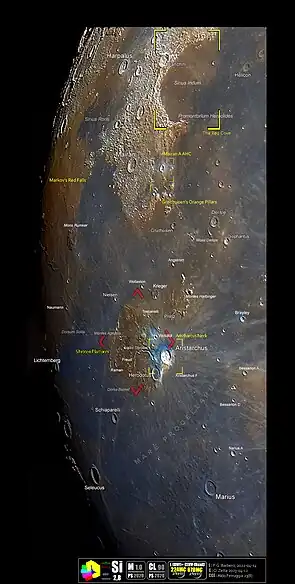Helicon (crater)
Helicon is a small lunar impact crater that is located on the north part of the Mare Imbrium. The crater was named after 4th century BC Greek astronomer Helicon of Cyzicus,[1] a friend and disciple of Plato.[2] To the northwest is the prominent Sinus Iridum, a mountain-ringed bay on the mare. Just to the east is the slightly smaller crater Le Verrier.
Lunar Orbiter 4 image | |
| Coordinates | 40.4°N 23.1°W |
|---|---|
| Diameter | 25 km |
| Depth | 0.5 km |
| Colongitude | 23° at sunrise |
| Eponym | Helicon of Cyzicus |

Helicon (top right) area in selenochromatic format holding some normal (yellow)/pyroclastic(red) selenochromatic landmarks
Highly oblique view of Helicon (left) and Le Verrier (right). The mountain on the horizon at left is Promontorium Laplace, about 180 km beyond Helicon. Note that Helicon's ejecta is buried by the mare lava, but Le Verrier's is not. From Apollo 15.
Another oblique view of Helicon (left), at a higher sun angle. Also from Apollo 15.
Helicon is a nearly circular formation with inner walls that curve down to a relatively flat floor. There is a tiny craterlet located at the midpoint of the interior, and a small craterlet along the southwestern rim.
Satellite craters
According to convention these features are identified on lunar maps by placing the letter on the side of the crater midpoint that is closest to Helicon.
| Helicon | Latitude | Longitude | Diameter |
|---|---|---|---|
| B | 38.0° N | 21.3° W | 6 km |
| C | 40.1° N | 26.2° W | 1 km |
| E | 40.5° N | 24.1° W | 3 km |
| G | 41.7° N | 24.9° W | 2 km |
References
- "Helicon (crater)". Gazetteer of Planetary Nomenclature. USGS Astrogeology Research Program.
-
 This article incorporates text from a publication now in the public domain: Mason, Charles Peter (1870). "Helicon". In Smith, William (ed.). Dictionary of Greek and Roman Biography and Mythology. Vol. 2. p. 372.
This article incorporates text from a publication now in the public domain: Mason, Charles Peter (1870). "Helicon". In Smith, William (ed.). Dictionary of Greek and Roman Biography and Mythology. Vol. 2. p. 372.
- Andersson, L. E.; Whitaker, E. A. (1982). NASA Catalogue of Lunar Nomenclature. NASA RP-1097.
- Bussey, B.; Spudis, P. (2004). The Clementine Atlas of the Moon. New York: Cambridge University Press. ISBN 978-0-521-81528-4.
- Cocks, Elijah E.; Cocks, Josiah C. (1995). Who's Who on the Moon: A Biographical Dictionary of Lunar Nomenclature. Tudor Publishers. ISBN 978-0-936389-27-1.
- McDowell, Jonathan (July 15, 2007). "Lunar Nomenclature". Jonathan's Space Report. Retrieved 2007-10-24.
- Menzel, D. H.; Minnaert, M.; Levin, B.; Dollfus, A.; Bell, B. (1971). "Report on Lunar Nomenclature by the Working Group of Commission 17 of the IAU". Space Science Reviews. 12 (2): 136–186. Bibcode:1971SSRv...12..136M. doi:10.1007/BF00171763. S2CID 122125855.
- Moore, Patrick (2001). On the Moon. Sterling Publishing Co. ISBN 978-0-304-35469-6.
- Price, Fred W. (1988). The Moon Observer's Handbook. Cambridge University Press. ISBN 978-0-521-33500-3.
- Rükl, Antonín (1990). Atlas of the Moon. Kalmbach Books. ISBN 978-0-913135-17-4.
- Webb, Rev. T. W. (1962). Celestial Objects for Common Telescopes (6th revised ed.). Dover. ISBN 978-0-486-20917-3.
- Whitaker, Ewen A. (1999). Mapping and Naming the Moon. Cambridge University Press. ISBN 978-0-521-62248-6.
- Wlasuk, Peter T. (2000). Observing the Moon. Springer. ISBN 978-1-85233-193-1.
External links
Wikimedia Commons has media related to Helicon (crater).
- Wood, Chuck (2006-08-20). "Out the Porthole". Lunar Photo of the Day. Retrieved 2016-09-18., excellent earth-based image of Sinus Iridum and vicinity, including Helicon and Le Verrier
This article is issued from Wikipedia. The text is licensed under Creative Commons - Attribution - Sharealike. Additional terms may apply for the media files.